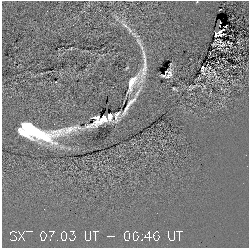
The soft X-ray "jets" were one of the truly new discoveries of Yohkoh/SXT, apparently one that was not anticipated by Skylab. Two papers in the Volume 44, No.5 (1992) special issue of the Publications of the Astronomical Society of Japan called attention to these beautiful objects, which we informally used to call "squirters". This may still be a good name, since "jet" means many things to many people, but "jet" has stuck. There are two basic types. One is the classical open-ended type, well associated with meter-wave Type III bursts and therefore showing the presence of open coronal magnetic field lines (quite interesting!). See a previous nugget for an introduction to to this subject. The second type of jet, not so well studied yet, is the kind termed the "two-sided loop jet" by Shibata and Shimojo. What we report here looks like a gigantic example of such a two-sided jet, and one with quite interesting properties.
The images below compare a routine two-sided jet with our big one:

In each frame, the numbers 1-2-3 show the jet, with 1 indicating its compact XBP (X-ray Bright Point) origin, an almost invariable feature of X-ray jets. As described in our earlier nuggets and copiously in the literature, these phenomena really look like the Heyvaerts, Priest and Rust model, which involves emerging flux interacting with the overlying coronal magnetic field. But we still lack good ideas about how this interaction takes place, and perhaps this gigantic two-sided jet can help us figure this out.
Here's a difference image showing the event (August 21, 1999) in its large-scale glory:

Here the dark circle represents the solar limb (a slight image misalignment) and gives the scale of the event. The projected distance between the footpoints is 690,000 km (astonishly coincidental with the radius of the Sun), so its unfolded length including the 3rd dimension probably exceeds 1,000,000 km. This is a usual difference image with the later image white; one can see some twisted structure and also the interesting hint of a dimming region just below the XBP. This results from flow along the structure, since the early image caught the jet already having started.
The "how fast" is the usual question asked by our jet guru, Kazu Shibata - the answer here is approximately 700 km/s, not allowing for projection. Such a speed suggests an MHD wave, rather than a fluid flow or a particle beam.
The difference image above shows a well-developed and complicated pattern of twisting, as shown below - it calls to mind the rotating motion seen in "simple" jets, using H-alpha spectra, by Canfield et al., 1996.

The difference here is that the a movie of the jet development strongly suggests that the twist is moving into the XBP, not away from it. Hmmm. Always something to think about - would this be consistent with untwisting as a source of energy?
We have seen other data - EUV images from SOHO, magnetograms, H-alpha - and these strongly suggest that the jet structure extends along a filament channel. This makes it reminiscent of the filament-channel activation we saw during the Flare Genesis balloon flight. Why did the filament not erupt? What are the filament field-lines tied to? How does such a large structure maintain itself in the face of the ceaseless solar convection? Some of these questions repeated below!
February 16, 2001